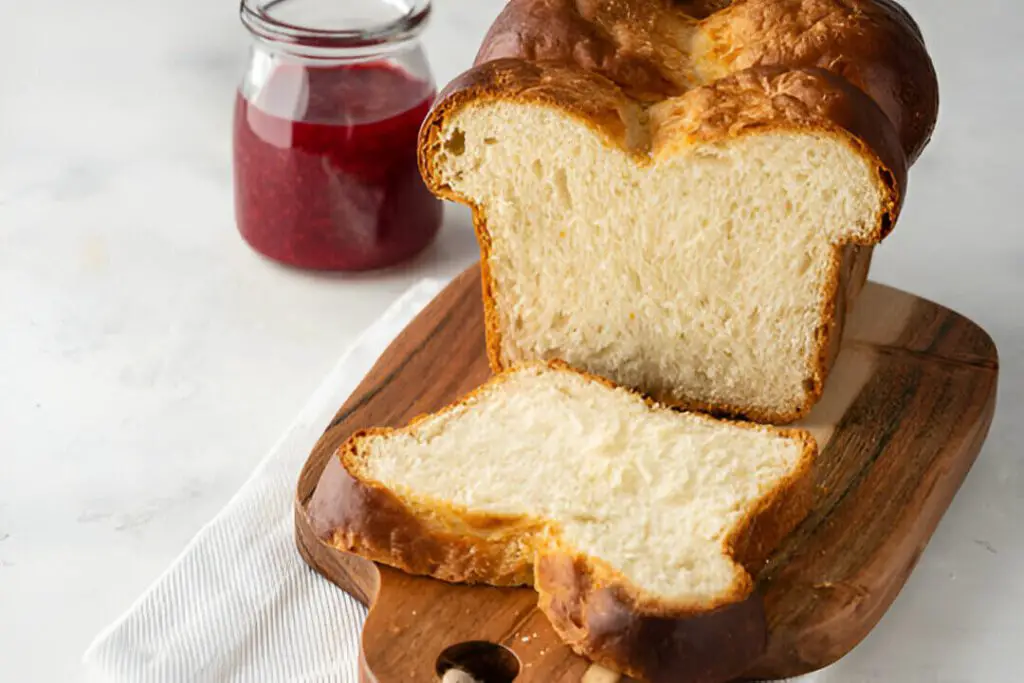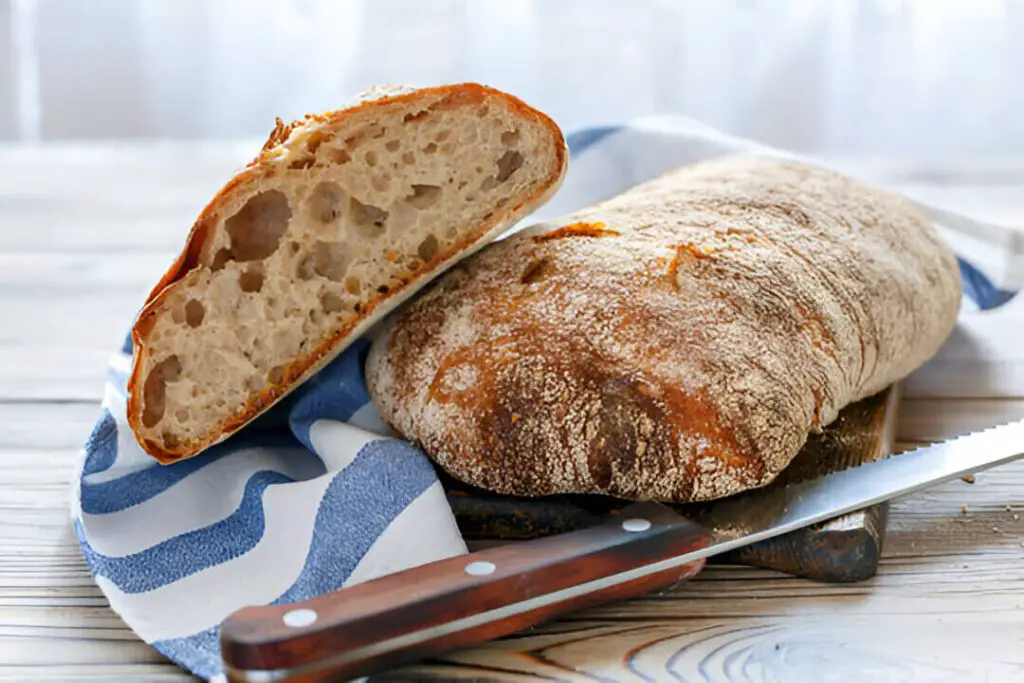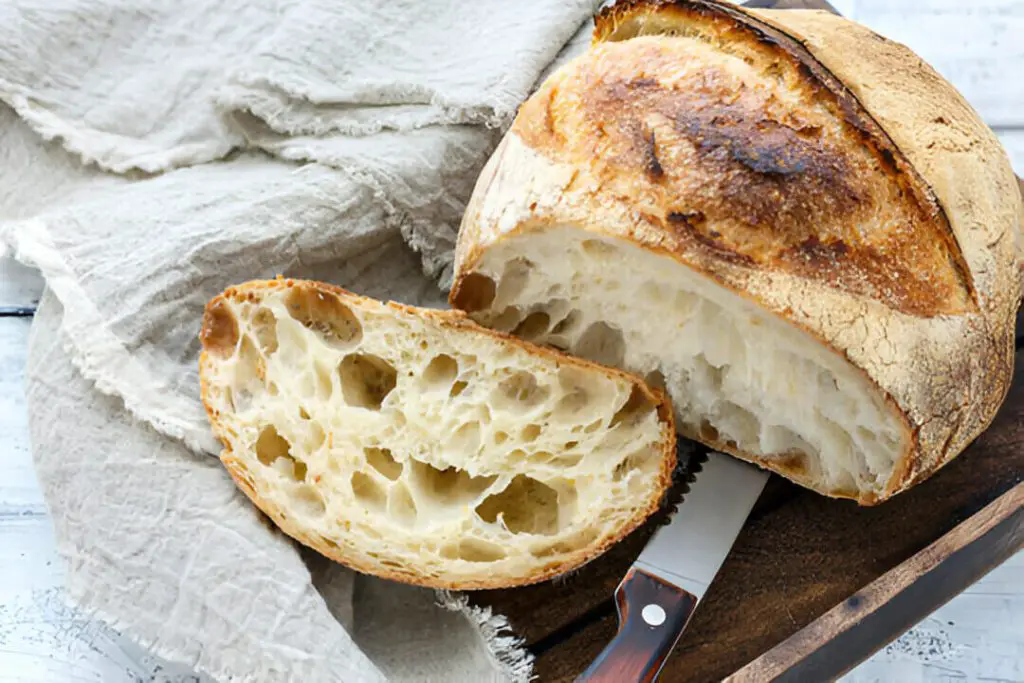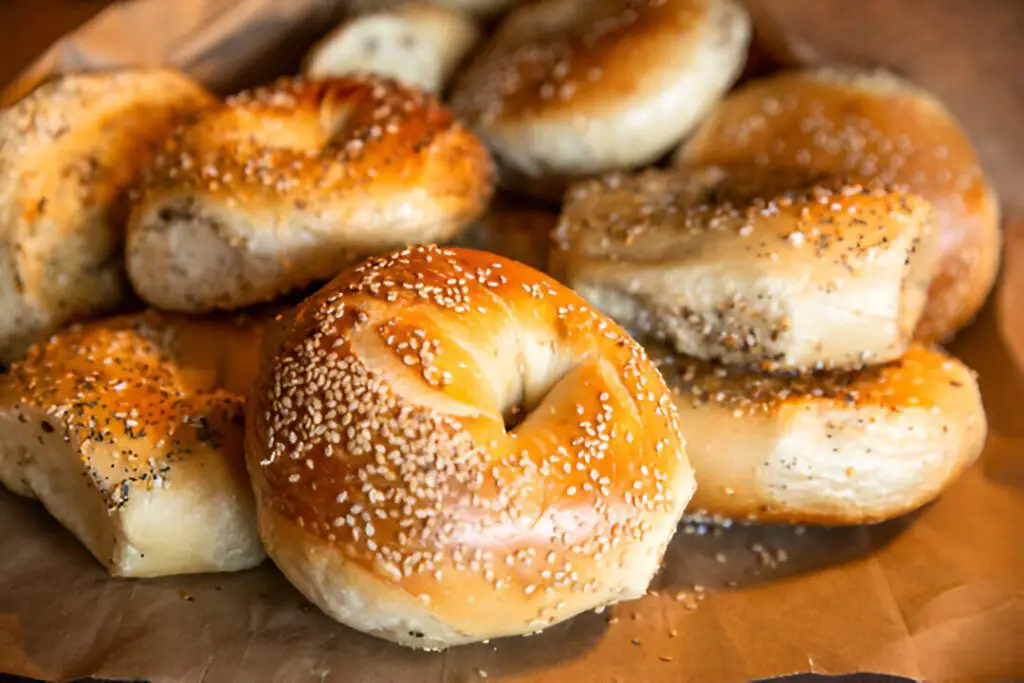Have you ever found yourself wanting to throw together a comforting bowl of French onion soup or a decadent bread pudding, only to realize you’re missing the key ingredient—French bread? I’ve been there too many times, rummaging through my pantry in frustration only to come up empty-handed.
Luckily, there are quite a few tasty substitutes for French bread that can save the day when you’re fresh out of baguettes. Now, I know “substitutes” probably have you warring—who wants to compromise the authentic flavors they’re craving? But don’t worry, I’m about to share some options that are so tasty you probably won’t even miss the French bread.
From fluffy brioche to crusty ciabatta, in this article, I’ll give you the skinny on the best breads to swap in depending on what you’re cooking. I’ll also clue you in on any prep steps to take to get these substitution stars oven-ready. By the time you’re done, you’ll feel confident enough to throw together your recipes using alternatives you likely already have on hand. So, what are you waiting for? Start reading to find your new favorite French bread fill-in!
Best Substitutes for French Bread
1. Brioche

When a sweet treat is what you’re after, look no further than brioche. This egg-enriched bread has a tender crumb and rich flavor that make it perfect for doling out in desserts like bread pudding. I like to think of brioche as the bougie cousin of French bread—a little fancier but totally worthwhile.
The only thing to watch out for is that straight out of the bag, brioche can be too soft to stand up to wetter preparations. That’s where my advice comes in: let it sit out at room temperature for a day or two before adding it to your recipe. This allows the bread to stale and firm up just enough that it won’t turn to mush.
I once made the mistake of throwing still-fresh brioche into a bread pudding and ended up with soggy chunks rather than the desired texture. But after letting slices air-dry for 48 hours, it held its shape beautifully. The result was a pudding so pillowy and indulgent, no one would have guessed it wasn’t made with classic French bread.
So next time your sweet tooth is acting up but regular bread just won’t do, reach for brioche. A little patience is all it needs to shine in place of a baguette. Just be sure to give it some time to dry out first; your taste buds will thank you later!
2. Ciabatta

If you’re in the mood for something savory, look no further than ciabatta. This olive oil-enriched Italian bread creates the perfect stand-in for French bread in recipes like French onion soup.
With its crispy crust and chewy interior crumb, ciabatta has a texture that’s almost identical to a baguette. The similarities don’t end there; both are made using simple doughs of flour, water, yeast, and salt. So you know ciabatta can stand up to moist fillings and toppings just as well as traditional French bread.
The best part is that Ciabatta is ready to use straight out of its packaging. There’s no need to let it stale, like with brioche. Just tear or slice the bread and add it straight to your dish. The bread’s structure will ensure it holds its own among other ingredients without disintegrating.
I remember the first time I turned to ciabatta instead of making a special trip to the store for French bread. My onion soup was just as delicious and creamy, with chunks of bread that softened perfectly into the broth rather than turning to mush.
Now ciabatta is my go-to swap when I want savory, French bread-sized pieces without much fuss. With its nearly identical flavor and texture, it’s the ideal one-for-one substitute.
3. Sourdough

If you’re a fan of crusty, artisanal breads, then sourdough is likely already a staple in your home. With its tangy, complex flavor, sourdough makes an excellent stand-in for French bread in dishes where you want something hearty with character.
Unlike more delicate breads, sourdough can hold its own in soups,casseroles, and other robust recipes. The thick crust won’t dissolve into a soggy mess, while the damp interior soaks up savory flavors. I especially love using sourdough in place of sandwich bread when making stuffing for roasted meats.
One major perk of sourdough is that it requires no specialized prep work before use. Just tear or cube the bread and add it straight to your recipe. The naturally sturdy structure means sourdough won’t break down prematurely.
The only thing to keep in mind is sourdough’s distinctive sour taste. It may be too overpowering for very mild-mannered dishes. But if you want your food to have an artistic twist, reach for this tangy bread instead of basic French bread. Sourdough will take your meal’s flavor profile to a whole new level.
So next time you’re in the mood to experiment, don’t overlook sourdough as a fresh and flavorful French bread alternative. Just toss it in and stand back—your taste buds will thank you!
4. Breadsticks

When a crunchy texture is what you’re after, breadsticks can save the day. These long, thin strips of bread have a crispy exterior that softens into a chewy middle—perfect for dunking into soups, stews, and more.
The good thing about breadsticks is that you can find flavor variations to suit any dish. Look for plain, garlic, or herb breadsticks for more neutral pairings. Or try flavored options like cinnamon or parmesan for maximum taste.
As with regular bread, there’s no prep needed before using breadsticks. Break or crumble them into your recipe and let the flavors meld together during cooking. The crunch they add is so satisfying.
I’ve used breadsticks to add extra bite to dishes like French onion soup and tuna noodle casserole. Leftover fast food breadsticks also make excellent impromptu croutons when Cubed and toasted.
So don’t underestimate the power of a simple breadstick. It stands in nicely for French bread when you want textural contrast rather than soft slices. Consider it your new go-to substitute for crispy cravings.
5. Bagels

When your pantry is full of bagels but lacking in French bread, don’t fret. With a little overnight soak, bagels can stand in flavor for sliced bread in recipes.
The trick is that straight out of the package, bagels tend to be dense and chewy—a bit much for things like bread pudding. But give cubes of bagel some time to absorb liquid, and their texture softens perfectly.
All it takes is tossing bagel pieces in your pudding, soup, or casserole mixture overnight in the fridge. By morning, the cubes soak up milks, broth, or other wet ingredients until plump and tender.
I like to prep my bagel mix-ins the night before so it’s one less step in the morning. The results are magically transformed bagel chunks that meld into the dish seamlessly. No one would suspect they weren’t made with sliced bread!
Best of all, bagels bring their subtle sweetness and signature crispy-on-the-outside chew to any recipe. It’s the perfect swap when you want that hearty bagel flavor without having to eat it plain.
6. Pumpernickel

For recipes with deep, roasted flavors, reach for hearty pumpernickel bread. With its dense, dark texture and slightly sweet-sour taste, it stands up beautifully to robust winter dishes.
The molasses and cocoa powder used to create pumpernickel’s distinctive color also imbue it with just the right amount of richness. Think pot roasts, stews, and casseroles full of spices like cinnamon, ginger and cloves.
Much like sourdough, pumpernickel’s thick crust won’t dissolve, keeping chunks intact as they soak up flavorful braising liquids. Its slightly sweet undertones also balance additions of salt and acid in a meal.
No special treatment is needed; just tear off pieces and stir them into your creation. Pumpernickel’s natural density means it holds its shape without effort.
When you want that je ne sais quoi of French bread but with more robust character, pumpernickel is the perfect stand-in. Its slightly sweet-tang delivers complexity to classic winter comfort recipes.
So don’t sleep on this hearty Whole grain option. When fruity, warm spices call your name, answer with pumpernickel in place of basic sandwich bread.
7. Portuguese Sweet Bread

When a seriously sweet fix is what you’re after, look no further than Portuguese sweet bread. Dense yet tender, each nibble is like a hug from warm cinnamon and sugar.
This egg-enriched loaf is perfect for snuggling up next to cups of chai or padding the bottom of breakfast bread puddings. Just a few cubes are all it takes to satisfy any dessert craving.
As with brioche, Portuguese sweet bread is quite soft when first baked. Letting loaf slices air-dry for a day or two firms them up just right. The texture balances the ultra-sweet flavor so each bite isn’t overwhelming.
Once dried, crumble the bread into your creation. As it absorbs liquids, the sweet bread melds into a beautifully tender-crisp matrix holding melting goodness.
However, don’t expect Portuguese sweet bread to work in savory recipes; this is a strictly sweet-tooth snack disguised as bread. For maximum enjoyment, savor it just as nature intended or nestled in something decadent.
8. English Muffins

When all else fails, have no fear—the classic English muffin is here! With its subtly sweet crumb and signature nooks and crannies, it’s a simple stand-in when standard sliced bread won’t do.
Much like bagels, English muffins require zero prep before use. Just tear or cut them into crouton-sized pieces straight from the packaging. Their naturally sturdy yet tender structure means they hold up well in wetter preparations.
Toast muffin chunks lightly for maximum crunch, or add them untoasted if you want softer bites. They soak up soups, stews, and savory flavors with ease.
I also love using English muffins instead of sandwich bread in stuffings and dressings. Their subtle sweetness plays nicely against bold herbs and spices.
If all you have is a six-pack of muffins languishing in the pantry, don’t let them go to waste! Consider this your reminder that they clean up nicely in place of baguettes. The results are simple, satisfying swaps.
So whenever French bread is MIA, English muffins have your back. Reach for their dependable nature; your taste buds won’t know the difference.
FAQs
Can I use these substitutes for French toast too?
Yes, most of the bread options suggested, like brioche, ciabatta, and challah, would work great as substitutes for French bread in French toast. Just follow the standard French toast recipe.
What if I don’t eat wheat bread? Are there any gluten-free substitutes?
Some good gluten-free substitutes for French bread include gluten-free sandwich thins, gluten-free bagels, or gluten-free breadsticks. You may need to soften them slightly more before using them in recipes.
Are there any low-carb substitutes for French bread?
Yes, good low-carb options include meathead bagels, carbquick sandwich bread, or cabbage bread. For recipes, you could also use slices of mushrooms or zucchini in place of bread to soak up sauces.
Can I use these substitutes for garlic bread?
Yes, many of the suggested breads, like ciabatta, baguettes, breadsticks, and sourdough, would work well as garlic bread substitutes. Just brush or rub them with olive oil, garlic, and herbs before baking.
Will these substitutes work for paninis or sandwiches too?
Absolutely. Ciabatta, baguettes, challah, and focaccia all have a structure that can withstand being pressed in a panini press or sandwich. Their flavors also complement fillings nicely.
Can these substitutes be used for croutons?
Yes, most of the bread options suggested, like sourdough, ciabatta, baguettes, and breadsticks, can be cubed and toasted to make croutons. The denser breads, like pumpernickel, may need a light soak first.
Do the substitutes all keep as long as regular French bread?
Storage times can vary. Most commercial breads, like ciabatta and baguettes, will last 3-5 days at room temperature. More artisanal options, like sourdough or brioche, may start going stale sooner. Bagels and English muffins can last over a week.
Can I freeze any of the substitutes for later use?
Yes, many bread substitutes freeze well, especially in resealable bags. Thaw frozen bread at room temperature before using. Brioche, challah, ciabatta, and bagels tend to hold up best to freezing. Sourdough and artisanal loaves may get crumbly.
Do the cooking times change at all with the substitutes?
Generally, no; the substitutes can be prepared using the same cooking times as regular French bread. However, denser breads like pumpernickel or brioche may need a few extra minutes to heat through fully.
Can I substitute different types of bread in one recipe?
Sticking to one type of bread substitute is best for consistency, but small amounts of different breads could work if they complement each other well flavor-wise.
Conclusion
In conclusion, while no substitute can perfectly replicate the flavor and texture of classic French bread, the options outlined here come very close in a pinch. The best substitute often depends on the specific recipe and your flavor preferences. But by choosing the right bread or roll—whether it’s ciabatta for savory dishes, brioche for sweet treats, or bagels or English muffins for simple swaps—you can still achieve delicious results without making a special trip to the store.
The next time you find yourself bread-shopping, consider keeping some of these alternative options on hand too for versatile use in place of plain old French loaf. With the right substitute bread in your pantry, you’ll always be rescued from a shortage.



